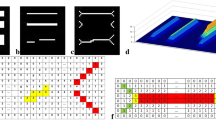Abstract
The article studies the handwriting recognition problem and the reduction of the text recognition problem from a text image to the text recognition problem from the trace of a pen writing the text. We propose a method based on a medial representation and reconstructing the pen trace from the handwritten text image. The method is substantiated based on an experimental study of character recognition from character images and from the reconstructed and true pen traces.




Similar content being viewed by others
REFERENCES
Krizhevsky, A., Sutskever, I., and Hinton, G.E., ImageNet classification with deep convolutional neural networks, in Adv. Neural Inf. Process. Syst., 2012, pp. 1097–1105.
Ojala, T., Pietikainen, M., and Hardwood, D., A comparative study of texture measures with classification based on feature distributions, Pattern Recognit., 1996, vol. 29, no. 1, pp. 51–59.
Lowe, D.G., Distinctive image features from scale-invariant keypoints, Int. J. Comput. Vision, 2004, vol. 16, no. 2, pp. 91–110.
Bay, H., Ess, A., Tuytelaars, T., and Van Gool, L., SURF: Speeded up Robust Features, Comput. Vision Image Understanding, 2008, vol. 110, no. 3, pp. 346–359.
Dalal, N. and Triggs, B., Histograms of oriented gradients for human detection, IEEE Comput. Soc. Conf. Comput. Vision Pattern Recognit. (CVPR 2005) (2005), vol. 1, pp. 886–893.
Pal, U., Wakabayashi, T., and Kimura, F., Comparative study of Devnagari handwritten character recognition using different feature and classifiers, 2009 10th Int. Conf. Doc. Anal. Recognit. (2009), pp. 1111–1115.
Ciresan, D.C., Meie, U., Gambardella, L.M., and Schmidhuber, J., Convolutional neural network committees for handwritten character classification, 2011 Int. Conf. Doc. Anal. Recognit. (2011), pp. 1115–1139.
Zhang, X.Y., Yin, F., Zhang, Y.M., Liu, C.L., and Bengio, Y., Drawing and recognizing Chinese characters with recurrent neural network, IEEE Trans. Pattern Anal. Mach. Intell., 2017, vol. 40, no. 4, pp. 849–862.
Zakharov, A.A., Barinov, A.E., Zhiznyakov, A.L., and Titov, V.S., Finding objects in images using a graph-based structural descriptor, Komp’yut. Opt., 2018, vol. 42, no. 2, pp. 283–290.
Lomov, N.A. and Arseev, S.P., Neural networks for shape recognition by medial representation, in Tr. Mezhdunar. konf. komp’yut. graf. zreniyu “Grafikon,” vyp. 28 (Proc. Int. Conf. Comput. Graph. Vision “Graphicon,” no. 28), Moscow: FGU “Fed. Issled. Tsentr Inst. Prikl. Mat. im. M.V. Keldysha Ross. Akad. Nauk”, 2018, pp. 218–221.
Blum, H.A., A transformation for extracting new descriptors of shape, Proc. Symp. Models Percept. Speech Visual Form, 1967, vol. 4, pp. 362–380.
Arseev, S.P. and Mestetskiy, L.M., Recognition of handwritten text from the reconstructed pen trace using the medial representation, in Informatsionnye tekhnologii i nanotekhnologii (ITNT-2020) (Information Technology and Nanotechnology (ITNT-2020)), Moscow, 2020, pp. 683–689.
Mestetskiy, L.M., Nepreryvnaya morfologiya binarnykh izobrazhenii: figury, skelety, tsirkulyary (Continuous Morphology of Binary Images: Figures, Skeletons, Circulars), Moscow: Fizmatlit, 2009.
Shaked, D. and Bruckstein, A.M., Pruning medial axes, Comput. Vision Image Understanding, 1998, vol. 69, no. 2, pp. 156–189.
Fischer, T., Online Handwritten Character Recognition with Capacitive Sensors, 2018. https://github.com/tobiasfshr/online-handwritten-character-recognition-capacitive-sensors .
Chung, J., Gulcehre, C., Cho, Kh., and Bengio, Y., Empirical evaluation of gated recurrent neural networks on sequence modeling, arXiv Preprint, 2014. .
Simonyan, K. and Zisserman, A., Very deep convolutional networks for large-scale image recognition, arXiv Preprint, 2014. .
Cohen, G., Afshar, S., Tapson, J., and Van Schaik, A., EMNIST: extending MNIST to handwritten letters, 2017 Int. Jt. Conf. Neural Networks (IJCNN) (2017), pp. 2921–2926.
Grother, P. and Hanaoka, K., NIST Special Database 19 Handprinted Forms and Characters. 2nd Ed. Tech.Rep. Online, Natl. Inst. Stand.Technol., 2016. http://www.nist.gov/srd/upload/nistsd19.pdf .
Neftci, E.O., Augustine, C., Paul, S., and Detorakis, G., Event-driven random back-propagation: enabling neuromorphic deep learning machines, Front. Neurosci., 2017, vol. 11, p. 324.
Funding
This work was supported by the Russian Foundation for Basic Research, project no. 20-01-00664.
Author information
Authors and Affiliations
Corresponding authors
Additional information
Translated by V. Potapchouck
Rights and permissions
About this article
Cite this article
Arseev, S.P., Mestetskiy, L.M. Character Skeleton as a Pen Trace Model for Recognition from Reconstructed Trace. Autom Remote Control 82, 1835–1845 (2021). https://doi.org/10.1134/S0005117921110011
Received:
Revised:
Accepted:
Published:
Issue Date:
DOI: https://doi.org/10.1134/S0005117921110011




